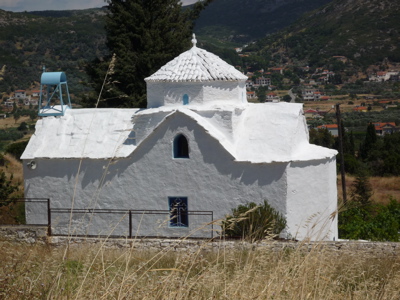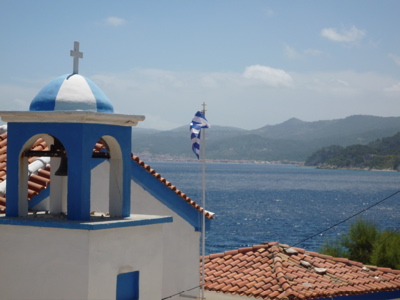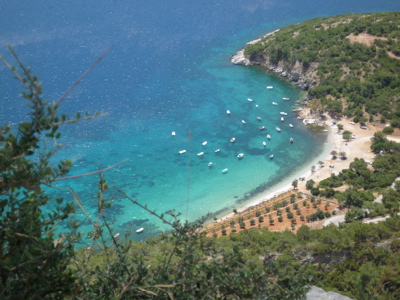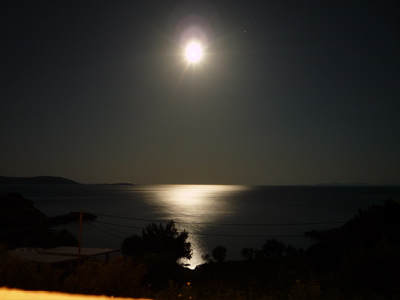DK3QN's Ham Radio Menu
Home CW QRP rigs QRO rigs Boatanchors Antennas Amplifiers EME SDRs Miscellaneous Impressum email
This page contains miscellaneous topics in a kind of "blog" style.
#1: Contest Logging Software: 'SD' by Paul, EI5DI
#2: miniVNA
#3: trip to Samos Island, Greece
Pick an item or just scroll down this page.
#1.
Contest Logging Software 'SD' by EI5DI (12-Nov-2009)
First of all, I need to confess that I'm not an enthusiastic
contester these days. I used to run a number of contests in the
first two decades of my ham radio life. The more recent contests where I took part had been as a member of the local club.
Like field day contests or other contests run under the club call sign.
There was always a knowledgeable guy around preparing and explaining the logging program handling to the rest of the
local ham fellow community. He also took care of the after-contest 'touch up' of the log file if somebody screwed-up some
bits.
I got sort of along with the various programs which all where MS Windows based, presenting a lot of nice dialog windows
with als sorts of information. Beautiful!
But I didn't like the handling of most of these programs. Anyway, I
didn't care about this because I had no better proposal
for and experience with a logging program where also non PC-freaks get along with.
Things changed suddenly when I was asked with short notice to participate in the 2009 2m Marconi CW contest in order
to collect some more points for my local club's 2009 German club championship participation.
And for that you are required to deliver computer logs to the 'authorities'.
I only had very few days left making up my mind what contest logger I was going to use and where I was pretty sure not
to screw up the whole thing right at the beginning.
Fortunately, I had come across and had downloaded a copy of EI5DI's 'SD' contest logger some time mid of this year and
had been playing around with the software for a couple of hours. For VHF contests there is a dedicated version of the
logger available, called 'SDV'. In general it presents the same user interface as 'SD', but includes some specifics for
VHF/UHF contests.
So I downloaded 'SDV' and entered into a trial run.
The 'SD/SDV' logger user interface is looking like a DOS Window and works like a DOS environment. No need for using
your mouse. Everything is accomplished by keyboard entries. Pretty fast plus very easy handling.
To make the story short: I got along quite well with the 'SDV' logger during the contest. I was working from a /p location
at a ham-friendly farmer's property. All went well with the logger and I thought to myself 'why haven't we used this logger
before for our club contest activities?'
So, everything went exceptionally well until the very end of the contest when I screwed up a bit. For savety reasons
I logged the last 10 QSO's on a paper log in order to enter them later on at home.
Before start spending hours in order to find out how to cure my 'problem' myself, I chose the 'lazy' way and dropped the
question on how my 'issue' could be solved into the 'SD' mailing list (see EI5DI website).
Within a few hours I got two emails back (one from EI5DI personally) explaining in detail what I need to do to get the log
complete and back on track.
Whow! That's what I call 'responsiveness'. Real great!
The rest was easy and my log now is complete.
The 'SD' logger is for free and can be downloaded here:
SD Logger by EI5DI
Give it a try!
For this time I've just used the logger for QSO entry. However the software can do a lot more sophisticated stuff. Please
visit EI5DI's website for more information.
A final personal comment:
If you like 'SD' and start using it as your standard contest logging software: if you can afford it, please consider making a
voluntary donation for Paul's efforts in order to keep his very good
work going. It's just a matter of showing your appreciation.
#2. MiniVNA: a low cost Vector Network Analyzer
I recently (Oct-2009) purchased a miniVNA from the local German distributor WIMO.
Cost was about 280 Euros.
I've owned and to some extent still own a few antenna analyzers. Typically, these are stand-alone boxes, which
means that they are operated sort of "self-contained". The "box" contains an Oscillator to send a signal to the antenna
plus electronic circuitry which measures what comes back the line (Coax, or close to 50 Ohms, that is).
With this kind of device it is rather cumbersome to analyze and adjust an antenna, especially if it is a multi-band antenna,
and adjust it according to the findings of the analysis. The analyzed data can only be recorded/documented by writing the
data down on paper for the inividual bands of operation.
The miniVNA, as far as SWR etc. measurements is concerned, will show all of the spectrum from LF to 180 MHz as far as
SWR, return loss, etc., is concerned. In addition it will "focus" on a frequency span that the user has selected.
For such kind of analysis a PC or Notebook is required. Connection to the miniVNA is done via USB. Controlling the miniVNA
and displaying it's findings is done via an MS-Windows program which comes with the unit.
Antenna SWR analysis and according adjustments of the antenna is done in a much shorter time frame compared with
"traditional" SWR analyzers.
Plus the miniVNA is capable of doing measurements beyond SWR etc. measurements, like filter and amplifier pass-band
analysis etc.
For the price highly recommended!
#3. June 2009: vacation trip to Samos Island, Greece




Early June we all (well, almost all) went to Samos by a kind of "last minute" trip.
Air Berlin took us safely and in time to Samos. The landing there reminded me a tiny bit of the landing at the
old Hong Kong Kai Tak airport when this was still in business until 1998 (I've been there many times and in case
you don't know what I mean look at this YouTube video).
However, the Samos landing by far was not quite so exciting besides the fact that the plane had to go through
a very steep curve very shortly before touch-down. Not too much space there in the plain where
Samos International Airport is located! But don't worry, it's a rather safe approach.
Samos is a beautiful and quiet place. Hotels are relatively small and go up to some 4 floors maximum. This
architecture keeps the scenery on Samos island quite natural. Samos has many hills and mountains (up to
some 1800 plus meters) leaving not much space for plain fields for agriculture.
People on Samos are very friendly, helpful and cooperative. English language is understood and spoken very
well, besides German, of course ;-)
Food is excellent, except if you are dialed-in for fast-food-chains: sorry, not on Samos Island!
Food is " mediterranean style", which means "very good"! You may need to adapt to this kind of kitchen a bit,
depending on your origin. Just give one of the "real" Greek restaurants a try! You'll love it!
In particular, try the seafood meals, a Greek salad, or one of the other local dishes!
Samos is also famous for it's wine. Well, that's a different story. In my taste it's rather sweet and strong. So I've
by-passed this experience on the long run. YMMV!
Samos is not a small island. If you want to travel around the Island I would recommend taking a rental car.
There are lots of rental car agencies on Samos, especially around the Airport at Pythagorion.
Rental cars start from rather small cars (i.e. especially true if you are from the US), but the rental cost are quite
reasonable. Driving a small car is not a draw-back in this case, because - as you will see - it's got a lot of benefit
when trying to get along in Samos City, e.g., very narrow roads!
You can't go fast anyway, as per the speed limits and the road conditions.
One more note on car rentals: "standard" cars' insurance is only covering driving on tarred roads! Any damage
caused by driving on other than tarred roads is not covered by the insurance. If you want to go "rough", you
should rent one of the small SUVs. In any case, ask the rental car company which kind of roads you are allowed
to drive with your particular rental car.
Best time to take a trip to Samos is probably May and early June time frame. After that it is said that the place
is getting pretty much packed and temperatures are getting high.
For ham radio the Samos callsign prefix is SV8, IOTA is EU-049. Of course I could not withstand but took my
little Elecraft K1 transceiver with me together with a couple of meters of antenna wire plus a 1:9 un-un.
On two late afternoons I took the rental car and drove up one of the hills in order to have a better take-off
for my radio waves. The K1 was powered by batteries and pushing out probably 1.5 to 2 watts only.
That was still good enough to work Japan on 30m during grey line propagation! Received RST report
was 579 (no contest RST exchange)! What a beautiful surprise!
Here is a picture gallery of our stay on Samos Island which may give you some impression of Samos.
back to "Welcome" screen



